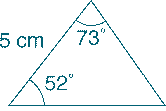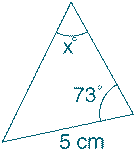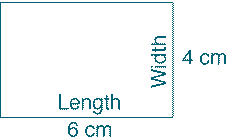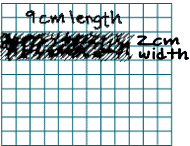|
 |
 |
 |
The TIMSS Mathematics Segment |
The following are sample items from the eighth-grade component of the TIMSS mathematics segment. These
samples represent four content areas examined by the test. The entire mathematics segment also included
questions about proportionality and data representation, analysis, and probability.
The international averages for this item indicate that working with percentages
is a challenge for students in most countries. Only about one-fourth of the
students responded correctly to this problem; Singapore students posted the best
performance with 78 percent of eighth graders answering it correctly.
Percent Increase in Price
(U.S. eighth-grade average correct: 20 percent)
If the price of a can of beans is raised from 60 cents to 75 cents, what is the percent
increase in the price?
Arrow symbol indicates correct answer.
|
A. 15%
B. 20% |
 |

|
C. 25%
D. 30%
|
|
One of the most difficult geometry items assessed understanding of the properties
of congruent triangles. Internationally, the average percentage of correct
responses was 35 percent for the eighth grade. About two-thirds of eighth-grade
students responded correctly in Japan, Korea, and Singapore.
Congruent Triangles
(U.S. eighth-grade average correct: 17 percent)
These triangles are congruent. The measures of some of the sides and angles of
the triangles are shown. What is the value of x?
Arrow symbol indicates correct answer. |

|
A. 52
B. 55
|
 |
C. 65
D. 73
E. 75
|
|


|
These two examples required the students to work with algebraic expressions and
equations. For the first item, students had difficulty recognizing that m+m+m+m
is equivalent to 4m. (Fifty-eight percent of all eighth graders answered this
correctly.) It is not surprising that students had even more difficulty
identifying the correct expression to represent the number of Clarissa's hats in
the next example. International performance on this item averaged 47 percent at
the eighth-grade level. Note that the U.S. student scores did not reflect the
international ranking for these questions. More U.S. students answered the hat
question correctly than the question about equivalent expressions.
Equivalent Algebraic Expressions
(U.S. eighth-grade average correct: 46 percent)
If m represents a positive number, which of these is equivalent to m+m+m+m ?
Arrow symbol indicates correct answer. |

|
A. m+4
B. 4m |
 |
C. m4
D. 4(m+1)
|
|
Expression Representing Number of Hats
(U.S. eighth-grade average correct: 49 percent)
Juan has 5 fewer hats than Maria, and Clarissa has 3 times as many hats as Juan.
If Maria has n hats, which of these represents the number of hats that Clarissa
has?
Arrow symbol indicates correct answer. |
A. 5-3n
B. 3n |
 |
C. n-5
D. 3n-5
|
 |
 |
E. 3(n-5) |
|
In most countries students had difficulty with the first part of this task
(drawing a new rectangle) on average 31 percent of all eighth graders provided a
correct drawing. For the second part of the problem, only 10 percent of students
internationally provided a correct ratio between the newly drawn and given
rectangles.
New Rectangle
(U.S. eighth-grade average correct: 16 percent)
|
 |
| a. In the space below, draw a new rectangle whose length is one and one
half times the length of the rectangle above, and whose width is half the width
of the rectangle above. Show the length and width of the new rectangle in
centimeters on the figure. |

|
| b. What is the ratio of the area of the new rectangle to the area of the
first one? |

|
Show your work.
(U.S. eighth-grade average correct: 10 percent)
| 
|
Excerpts from: Beaton, A.E., et al. (1996) Mathematics achievement in the middle
school years: IEA's third international mathematics and science study. Chestnut Hill,
MA: TIMSS Intenational Study Center.
Classroom Compass Back Issues: Issue 3.3 Contents:
Previous
Next
|
|
 |
 |







